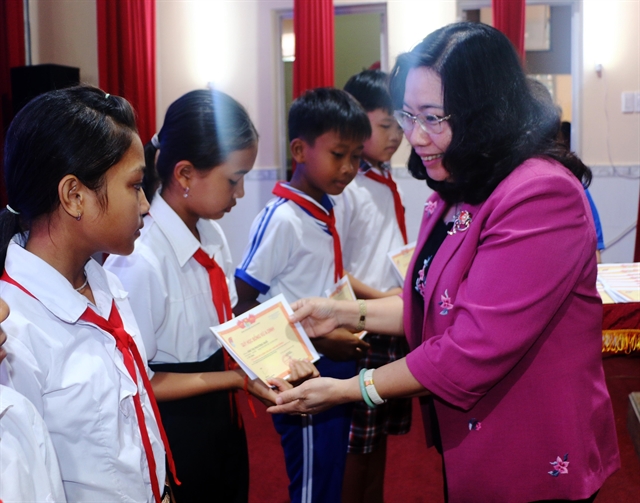 Society
Society

 |
| Hồ Thị Cẩm Đào, deputy secretary of the Sóc Trăng Province Party Committee, presented Vừ A Dính scholarships for ethnic students in Sóc Trăng Province in April. — VNA/VNS Photo Tuấn Phi |
SÓC TRĂNG — The Cửu Long (Mekong) Delta province of Sóc Trăng has taken various measures to develop the areas where ethnic people live and improve their lives.
Lý Rotha, head of the province's Ethnic Minority Affairs Committee, said the province has had 64 of its 80 communes recognised as new-style rural communes under the country’s programme of building new-style rural areas.
Of the 64, 31 are ethnic people communes, he said.
Ethnic people, mostly Khmer people, account for 35 per cent of the province’s population.
The province has the largest number of Khmers in the delta, with 28 per cent of its population being Khmer people.
It is using VNĐ790 billion (US$33.5 million) to implement the national target programme for socio-economic development in ethnic minority and mountainous areas in 2021-25.
Last year, the programme built 63 projects for rural areas, including 48 roads, 11 bridges, one community house and three markets.
Trần Đề District, where ethnic people make up more than 50 per cent of its population, has spent more than VNĐ9 billion ($380,000) to implement 10 rural transport projects in living areas of ethnic people since 2021.
Tăng Thị Sol, an ethnic person in Bưng Triết Hamlet in Trần Đề’s Liêu Tú Commune, said that previously the old Tà Óc Bridge was narrow and deteriorated, did not secure travel safety and had been rebuilt.
“The new bridge is wide and secures travel safety, especially for transporting agricultural products in Bưng Triết and neighbouring hamlets, and people here are glad,” she said.
The district has supported ethnic people to find jobs and provided them household utensils such as water containers.
Phan Thị Tám in Liêu Tú Commune has been given a 2,000 litre container for storing clean water. Previously, she stored clean water for household use in pots which could only store water enough for her family use for one or two days.
“The 2,000 litre container provides more water. It has a lid which helps prevent mosquitoes from laying eggs,” she said.
Last year, the province provided clean water for 267 households, housing land for 213 households, houses for 623 households and farming land for 230 households.
All poor and near poor ethnic people in the province are provided free health cards.
Up to 97.5 per cent of ethnic households can access hygienic water.
Rotha, head of the province Ethnic Minority Affairs Committee, said the national target programme for socio-economic development in ethnic minority and mountainous areas in the province will focus on investing in socio-economic development in areas of Khmer people and reduce poverty rapidly and sustainably.
It will provide housing and farming lands and supply clean water for nearly 4,500 households at a total cost of VNĐ176 billion ($7.5 million) to serve the production and lives of ethnic people by 2025, he said.
It will develop ethnic boarding schools and schools which have a large number of ethnic students, and buy equipment for teaching ethnic students, he said.
It will preserve the culture of ethnic minorities, invest in television and radio systems and apply information technology for socio-economic development in ethnic people areas, he said.
The province plans to increase the average income of ethnic people to VNĐ70 million ($3,000) per person a year by 2025.
It has a total of 15,139 poor households as of the end of last year, including 7,122 Khmer households and 345 Hoa households.
The number of poor Khmer households accounted for 7.1 per cent of the province’s Khmer households last year, down by 3 per cent against 2021.
The province aims for all communes, wards and towns to have paved roads for car travel to their centres and up to 90 per cent of roads in hamlets and villages paved with cement or asphalt.
It also aims for 99 per cent of ethnic households to access national power grids and other power supply sources.
The province has focused on preserving the cultures and traditional values of ethnic minorities.
In April, the province Department of Culture, Sports and Tourism began drafting up a plan of preserving and promoting the traditional cultural values of ethnic minorities in combination with developing tourism for this year.
Under the plan, the province’s Museum, in co-operation with relevant agencies of districts, towns and Sóc Trăng City, will survey and collect musical instruments, items related to traditional crafts and food, and households utensils of Khmer and Hoa ethnic people.
Trần Minh Lý, director of the Department of Culture, Sports and Tourism, said the department has implemented the plan since 2021 and will continue to implement it well.
It will continue repairing hamlet-level cultural houses which are deteriorated, he said.
In the first half of the year, the province has organised 36 art performances at 12 places in rural, remote and ethnic people-inhabited areas, attracting the view of 36,000 people. — VNS